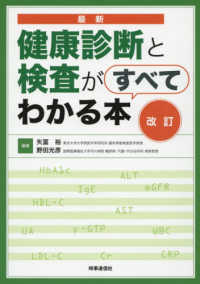Full Description
For more than a decade, Sports Emergency Care: A Team Approach has filled a void in athletic training education on the subject of emergency care. Now, this updated Third Edition continues to pave the way to prepare athletic training students beyond traditional first aid training as well as providing specific information on emergency situations in sports for emergency medical services (EMS) professionals.
In this updated Third Edition, Dr. Robb S. Rehberg and Dr. Jeff G. Konin, along with their 13 contributors, have created a resource that can be used in athletic training education programs as a core text in a sports emergency care course; a supplemental text in several courses that address immediate care within an athletic training education curriculum; and it can be used by EMS educators in developing continuing education programs for prehospital providers.
Some of the topics included in the Third Edition:
Assessment of Sports Emergencies
Cardiovascular Emergencies
Management of Traumatic Brain Injury
Fractures and Soft Tissue Injuries
Managing Mental Health Emergencies
Care of Athletes with Disabilities
Emergencies in Sports for the Aging Athlete
Regardless of discipline, it is important for all health care providers caring for ill or injured athletes to be knowledgeable and proficient in managing sports emergencies. This ability can only be achieved through preparation and practice, and Sports Emergency Care: A Team Approach, Third Edition continues to be a groundbreaking text that gives access to the essential resources health care providers need to address sports emergencies. This includes but is not limited to athletic trainers, emergency medical technicians and paramedics, and physicians.
From the Foreword:
"Emergencies can occur anytime and anywhere in sports, including at a practice or on the bus traveling to an event. After nearly 40 years as a professional sports athletic trainer, these emergency moments give me pause. Preparation is the key to successful outcomes in all emergencies."
—Ronnie P. Barnes, MS, ATC
Senior Vice President, Medical Services
Head Athletic Trainer
New York Football Giants
Contents
Dedication Acknowledgments About the Authors Contributing AuthorsPreface Foreword by Ronnie P. Barnes, MS, ATC Chapter 1 Introduction to Sports Emergency CareRobb S. Rehberg, PhD, ATC, NREMT Chapter 2 Preparing for Sports EmergenciesRobb S. Rehberg, PhD, ATC, NREMT and Jim Kyle, MD, FACSM Chapter 3 Assessment of Sports EmergenciesRobb S. Rehberg, PhD, ATC, NREMT Chapter 4 Airway Management and BreathingRobb S. Rehberg, PhD, ATC, NREMT Chapter 5 Cardiovascular EmergenciesRobb S. Rehberg, PhD, ATC, NREMT Chapter 6 Care Concepts in Management of the Spine-Injured AthleteRon Courson, ATC, PT, NRAEMT, CSCS;Robb S. Rehberg, PhD, ATC, NREMT; and Michele J. Monaco, DSc, ATC Chapter 7 Unconsciousness and SeizuresDavid A. Middlemas, EdD, ATC, CCISM Chapter 8 Management of Traumatic Brain InjuryCasey Christy, MA, ATC, CSCS Chapter 9 Injuries to the Thoracic RegionMichael A. Prybicien, MA, ATC, PES, CES Chapter 10 Abdominal and Pelvic InjuriesDavid A. Middlemas, EdD, ATC, CCISM Chapter 11 Fractures and Soft Tissue InjuriesMichael A. Prybicien, MA, ATC, PES, CES andLouis Rizio III, MD Chapter 12 General Medical EmergenciesJohn L. Davis, MS, ATC Chapter 13 Environmental EmergenciesRebecca M. Lopez, PhD, ATC, CSCS Chapter 14 Managing Mental Health EmergenciesEileen Lubeck, PsyD Chapter 15 Emergency Care Considerations for the Pediatric and Youth AthleteRebecca M. Lopez, PhD, ATC, CSCS andJeff G. Konin, PhD, ATC, PT, FACSM, FNATA Chapter 16 Care of Athletes With DisabilitiesAaron Rubin, MD, FAAFP, FACSM andLauren M. Simon, MD, MPH, FACSM, FAAFP Chapter 17 Emergencies in Sports for the Aging AthleteDavid Pezzullo, MS, PT, SCS, ATCAppendix Equipment Removal Techniques Financial Disclosures Index








